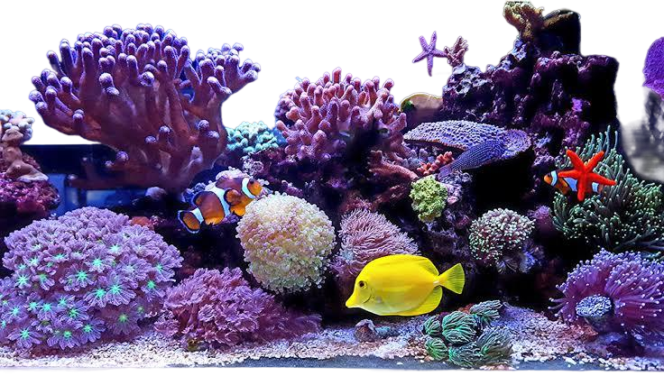For approximately two years, my friend Mike has considered getting a saltwater tank.
He has hesitated because of concerns about the difficulty and expense of a marine setup.
In my experience, setting up a saltwater aquarium can be both simple and affordable, and I want to share how.
My recommendations are not sponsored, and I purchased all the equipment with my own funds. Let us begin.
What is the Best Beginner Saltwater Tank?
The tank I have chosen is a Fluval Evo 13.5. It is a stylish, compact tank that will look good in any room.
It is also small, which makes it easy to maintain, yet it is still large enough to accommodate a decent selection of easy-to-keep fish and corals.
Crucially, the design is simple, without intimidating components like a sump or a skimmer to understand.
It comes with all the equipment you need to get started and costs just 140 pounds in the United Kingdom or approximately 180 dollars in the United States.
Where Should You Place Your Aquarium?
First, you will need to choose a location for the tank.
You will enjoy it more and neglect it less if you put it somewhere you will see it all the time.
The Evo measures just under 2 feet long and 1 foot wide, allowing it to fit in most spaces.
A kitchen worktop or side cabinet make ideal locations, and I plan to keep my aquarium in my home office to provide a sense of calm during hectic video meetings.
You will need to ensure the surface is level to avoid unnecessary pressure on the glass joints.
Furniture shims can help achieve a mostly level surface, but for good measure, I am also using a cut-to-size aquarium leveling mat to correct any remaining slight angles.
The tank’s small overhang conveniently hides the edges of the leveling mat.
What Kind of Rock Do You Need for a Saltwater Tank?
Next, you will need to add your rockscape. It is best to use rock specifically for marine aquariums rather than freshwater rock or ornaments.
The rock in a saltwater tank acts as filtration, and anything else will be less effective and may even leach harmful substances into your water that your corals will not like.
Man-made rock that is safe for saltwater tanks is available for less than 50 pounds.
One popular option is Real Reef Rock, which has a distinct purple appearance.
You should buy enough pieces to fill around one-third to one-half of the tank.
You do not need to be particularly creative; just use a couple of pieces that have gentle angles for easy coral placement and ideally a few holes or caves for your fish to hide in at night.
Should You Buy a Custom Aquascape?
As an alternative, I chose to commission a custom piece from a company called RR Aquascapes in the United Kingdom.
It was expensive at 100 pounds, but the resulting aquascape creates a beautiful aesthetic in the tank, has great angles and ledges for easy coral placement, and plenty of hiding places to help keep my fish relaxed.
How Do You Add Saltwater to Your Tank?
We are ready to add saltwater. The easiest way to do this is to buy it pre-mixed from your local fish shop.
I bought two 25-litre barrels of saltwater for 15 pounds, which is plenty because the tank holds approximately 40 litres, not the advertised 52.
There is no magic to adding the saltwater; you just pour it in, trying your best not to splash everywhere.
The use of anti-glug containers helps prevent splashing, a feature I find incredibly useful.
Can You Mix Your Own Saltwater?
You can mix saltwater yourself at home, but you must not use tap water because it contains contaminants that are harmful to corals and that will lead to algae outbreaks.
Doing so requires a special filter called a Reverse Osmosis Deionization filter that strips all impurities out of your tap water.
These filters are a very good upgrade later on, but buying pre-mixed saltwater eliminates the complication, so for a first setup, I am keeping it simple.
What Heater and Pump Should You Use?
Once the saltwater is in, you will need to add a heater, which is the only required piece of equipment not included with the tank.
A 50-watt heater will do just fine, and I am using a Fluval E-series heater set to $25^{\circ}C$ or $77^{\circ}F$.
Then you can add the included pump to circulate water through the filtration section.
The pump’s power cable is quite short, so you will need either a socket close to the tank or a short extension cable.
It is worth turning the pump on straight away so your heater can bring your tank up to temperature.
How Do You Add Sand to a Saltwater Aquarium?
Next, I am going to add the sand.
You can add sand first, but it just means you need to be more careful when you are pouring the water in, so for my setup, I have chosen to add the sand after the water.
You will want to rinse the sand off first to keep any fine dust particles out of your tank, which involves running it under a tap for 10 minutes until the water runs clear.
I am using 2 kilograms of fine-grain sand because it looks nice and is slightly easier to keep clean than more coarse sand, but the grain size is largely just personal preference, so use whatever marine-specific sand you want.
I would not recommend you use non-marine specific sand, but if you do, conduct research to ensure it will not leach anything into your tank.
How Does the Filtration Work in a Beginner Tank?
Now we are ready to set up the filtration, which for a tank of this type is very straightforward.
The tank includes a sponge filter, a bag of activated carbon, and porous ceramic media for hosting beneficial bacteria.
Since activated carbon primarily removes water discoloration, I am setting it aside for now.
New saltwater is about as crystal clear as it gets, so I will not need the activated carbon to clean the water until I have been feeding for a good few weeks.
The ceramic media requires a gentle rinse before being placed in the tank.
Its small bag fits neatly inside the sponge filter, ensuring all water passes through it.
The water flows from an intake into the middle filtration section containing the sponge and ceramic media.
From there, it exits at the bottom, passes through the pump, and returns to the main display area of the tank.
It is a very simple setup, and that is all you need to do with filtration.
There are various optional upgrades for the tank’s filtration system, but they are not necessary for a basic setup.
I plan to cover those in the future.
What Lighting is Needed for a Simple Saltwater Tank?
For illumination, the Evo includes a built-in light that fits into a groove in the lid.
While the light is totally adequate for the simple fish and corals that will go in the tank, I would describe its functionality as basic.
Control is limited to an on/off switch, with a choice between blue or white light.
I recommend using the white light 90 percent of the time, switching to the blue light occasionally to showcase the fluorescence of corals once they are added.
You will need a plug timer for the light to make sure you do not forget to turn it off at the end of the day.
Is Setting Up a Saltwater Tank Really That Simple?
To my friend Mike, if you were waiting for a complicated step, I must disappoint you. The tank is now completely set up.
The next steps are simply to add bottled bacteria and then the first fish.
I will explain the process of adding bacteria and the various fish options in a future discussion, but no other steps are required at this stage.
The upgrades I mentioned are optional, not essential, making the current setup complete.
How Much Does a Beginner Saltwater Tank Cost?
The total cost for all the components needed to get the tank to its current stage is approximately 110 pounds, in addition to the price of the tank itself.
This brings the grand total to 250 pounds.
A standard setup would be based on spending 50 pounds for rock, rather than the 100 pounds I spent on a bespoke aquascape.
My friend Mike is unaware that I am writing about my experience, but I hope my efforts provide some gentle encouragement for him.
I welcome any questions from readers as well.
Conclusion
To set up your first saltwater aquarium easily and affordably, start with a compact, beginner-friendly tank such as the Fluval Evo 13.5, which holds approximately 40 liters.
Place it on a stable, level surface in a spot where you will see it often, as frequent viewing makes maintenance more enjoyable and consistent.
Add marine-specific rock to fill about one-third to one-half of the tank, which will serve as your primary source of biological filtration.
Use pre-mixed saltwater for convenience and pour it in carefully.
Install a 50-watt heater set to 25 degrees Celsius, along with the included circulation pump, to ensure proper water movement.
Rinse fine-grain marine sand thoroughly and add it as your substrate.
Set up the sponge filter with ceramic media to support beneficial bacteria.
The built-in light can be set to white for regular use and switched to blue occasionally to enhance coral fluorescence. Use a plug-in timer to automate lighting.
The total cost to reach a functional state, excluding the tank, is approximately 110 pounds.

My name is Chibuzor Abraham Mba, and I’m the aquarist behind this website. I’ve spent years exploring the fascinating world of aquariums—especially small-scale tanks like nano and pico setups. Over time, I’ve made my fair share of mistakes, and through each one, I’ve learned valuable lessons.
